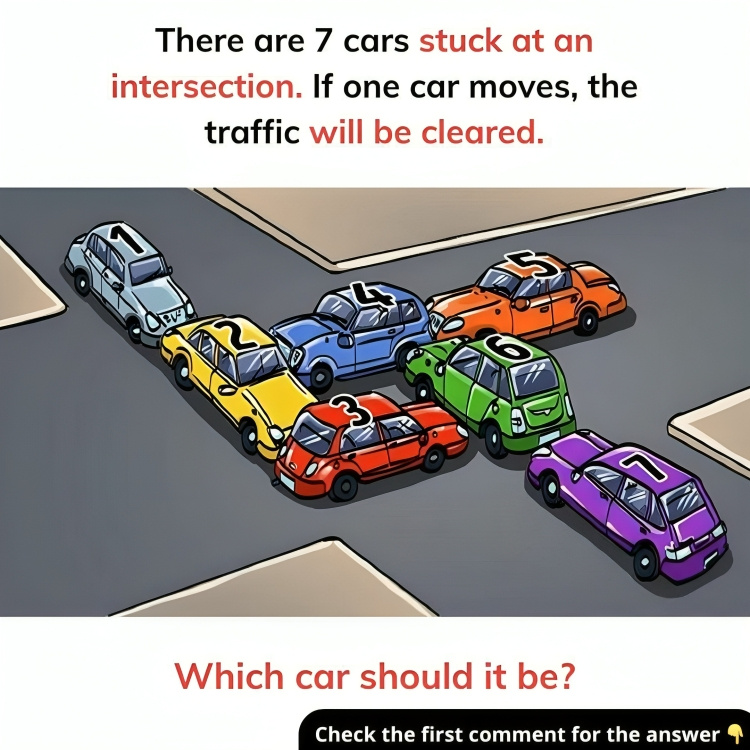If one car moves, the traffic will be cleared. Which car should it

Traffic jams are a common problem in cities worldwide, often caused by one poorly positioned vehicle or an intersection bottleneck. In this particular scenario, we’re looking at seven cars stuck at an intersection. The question is simple yet intriguing: which car needs to move to clear the traffic? Let’s break it down.
Understanding the Traffic Problem

At first glance, a congested intersection might seem like a puzzle with no solution. But, like many traffic problems, the answer lies in identifying the key obstruction. Imagine the scene: seven cars stuck in a gridlock, each waiting for the other to move.
The key to resolving this scenario is recognizing the car that’s causing the block. It’s not always obvious, but by analyzing the situation carefully, we can identify the single car that holds the power to break the gridlock.
The Critical Role of Car Number 3
Based on the setup, car number 3—positioned in the center of the intersection—is the one causing the problem. Here’s why:
Blocking All Directions: Car number 3 is sitting right at the heart of the intersection, obstructing the flow of traffic in all four directions.
Impact on Other Cars:
Cars 1 and 2 cannot proceed because car 3 is in their path.
Cars 4 and 5 are similarly blocked by car 3’s position.
Cars 6 and 7, although further back, are indirectly affected because the traffic flow depends on car 3 moving first.
Car 3’s location is like a cork in a bottle. Until it moves, nothing else can flow.
Why Moving Car 3 Clears the Traffic
The moment car number 3 moves out of the intersection, the logjam resolves itself. Here’s how:
–Cars 1 and 2 Can Proceed: With car 3 out of the way, cars 1 and 2 can drive forward, clearing their lanes.
–Cars 4 and 5 Gain Freedom: Once cars 1 and 2 move, cars 4 and 5 have space to advance in their respective directions.
–Cars 6 and 7 Are No Longer Stuck: The ripple effect of cars 1, 2, 4, and 5 moving clears the way for cars 6 and 7 to proceed.
By shifting one car—car 3—the entire system becomes functional again.

Lessons in Traffic Management
This scenario highlights a broader lesson about traffic management and problem-solving. Often, resolving congestion isn’t about massive interventions but identifying the one critical factor causing the block.
1. The Domino Effect of Traffic Flow
In traffic, like in life, one small action can have a significant impact. Moving a single car can set off a chain reaction that restores order and flow.
2. The Importance of Intersection Design
Intersections are common choke points in urban traffic systems. Ensuring they are well-designed and properly managed can prevent situations like this from arising in the first place.
3. Decision-Making Under Pressure
When faced with a jam, drivers and traffic officers alike need to assess the situation quickly and decide which vehicle should move first to untangle the mess.
Real-Life Applications of This Principle

While this scenario might sound hypothetical, similar situations occur daily in busy cities. Traffic officers, autonomous vehicles, and even advanced AI systems use similar principles to manage flow and reduce congestion.
How to Avoid Intersection Gridlocks
Prevention is always better than a cure. Here are some practical tips to avoid getting stuck in situations like this:
Obey Traffic Signals: Always adhere to lights and signs to prevent unnecessary chaos at intersections.
Avoid Entering a Blocked Intersection: If you can’t cross completely, wait until the intersection clears. Blocking an intersection creates gridlock.
Stay Aware of Your Surroundings: Keep an eye on other vehicles and anticipate their movements to avoid getting stuck.
Conclusion: A Simple Move Resolves a Complex Problem
In this scenario, the solution to the traffic jam was straightforward: car number 3 needed to move. This simple action freed up the flow in all directions, proving that even the most tangled situations often have a clear and logical resolution.
By applying this principle to real-life traffic management, drivers and city planners can reduce congestion and keep roads moving smoothly. The next time you find yourself stuck at an intersection, take a moment to identify the key blockage—your quick decision might just save the day!
These are old classic mathematical problems. When you were in middle or high school.
These tests are more fun when you find yourself trying to remember the math you learned as a child.
90% Fail to Answer This Correctly!
So now I will treat you to a math problem designed for school students. But it’s not that simple for those who graduated decades ago. It’s easy to forget the order of operations as we grow older.
The question now: Can you solve this equation?
Time to use that head of yours.
Yeah, it’s not that simple, but as I said, not even 50% get it right at first.
Now to the brainteaser – can you figure out the answer? Try to think back on the mathematical rules!
A
B
C
ANSWER:
Below, we’ll show you the answer.
You get this if you see that the ones at the end of each row have no sign between them and the next one.
Therefore, they are actually 22s.
The “2 x 0” on the last line becomes 0. Multiplication must always be solved before addition if there are no parentheses.
2+2+2+2+22+2+2+2+22+2×0+2=60.
The solution is 60.
Did you solve it correctly?
The Cognitive Benefits of Quizzes for the Human Brain
Quizzes are often associated with classrooms and game shows, but their benefits extend far beyond entertainment or academic assessment. They are powerful tools that can enhance brain function, improve memory, and promote lifelong learning. Recent research in cognitive psychology and neuroscience highlights the positive effects of quizzing on brain health and intellectual development.
One of the most significant benefits of quizzes is the testing effect. This phenomenon suggests that retrieving information from memory, as one does during a quiz, strengthens that memory more than simply re-studying the information. When individuals actively recall facts or concepts, neural connections associated with that knowledge become more robust. This improves long-term retention and makes it easier to retrieve the information in the future. In short, quizzing reinforces learning in a way that passive review does not.
Quizzes also encourage active learning. Unlike reading or listening, taking a quiz requires the learner to engage with the material, think critically, and apply knowledge. This active engagement helps the brain encode information more deeply. As a result, learners are more likely to understand and remember the content, rather than merely memorize it.
Additionally, quizzes enhance metacognition, or the awareness of one’s own knowledge and thought processes. When individuals take a quiz, they receive feedback—either immediately or afterward—that helps them evaluate what they know and what they still need to learn. This process fosters self-awareness and helps learners adjust their study strategies for more effective outcomes. Knowing which areas are weak or strong allows for targeted practice, which is crucial for skill development.
Regular quizzing can also improve attention and focus. When people expect to be tested, they are more likely to concentrate during the learning phase. This heightened attention boosts the quality of learning and helps prevent the common problem of mind-wandering. Over time, the habit of focusing in preparation for quizzes can lead to improved concentration in other areas of life as well.
Beyond the cognitive benefits, quizzes also provide emotional and motivational advantages. They offer a sense of achievement, especially when learners see progress over time. This can increase motivation, reduce anxiety around testing, and build confidence in one’s abilities. Quizzes with gamified elements, such as points or levels, can also make learning more enjoyable and engaging.
From a neurological perspective, the brain thrives on challenge and novelty—two key features of well-designed quizzes. They stimulate the brain’s reward system by offering immediate feedback and small successes, keeping the learner mentally engaged. Furthermore, regular mental challenges such as quizzes are associated with a reduced risk of cognitive decline as people age, suggesting they may even contribute to brain health over the long term.
In conclusion, quizzes are far more than academic exercises. They are dynamic cognitive tools that reinforce memory, encourage active engagement, sharpen focus, and promote self-awareness. Whether used in schools, professional training, or self-study, quizzes play a vital role in enhancing learning and maintaining a healthy, active brain.
